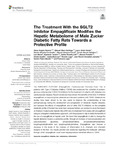The Treatment With the SGLT2 Inhibitor Empagliflozin Modifies the Hepatic Metabolome of Male Zucker Diabetic Fatty Rats Towards a Protective Profile

Use este enlace para citar
http://hdl.handle.net/2183/30671
A non ser que se indique outra cousa, a licenza do ítem descríbese como Atribución 4.0 Internacional (CC BY 4.0)
Coleccións
- Investigación (EPEF) [590]
Metadatos
Mostrar o rexistro completo do ítemTítulo
The Treatment With the SGLT2 Inhibitor Empagliflozin Modifies the Hepatic Metabolome of Male Zucker Diabetic Fatty Rats Towards a Protective ProfileAutor(es)
Data
2022-01-02Cita bibliográfica
Aragón-Herrera A, Otero-Santiago M, Anido-Varela L, Moraña-Fernández S, Campos-Toimil M, García-Caballero T, Barral L, Tarazón E, Roselló-Lletí E, Portolés M, Gualillo O, Moscoso I, Lage R, González-Juanatey JR, Feijóo-Bandín S and Lago F (2022) The Treatment With the SGLT2 Inhibitor Empagliflozin Modifies the Hepatic Metabolome of Male Zucker Diabetic Fatty Rats Towards a Protective Profile. Front. Pharmacol. 13:827033. doi: 10.3389/fphar.2022.827033
Resumo
[Abstract] The EMPA-REG OUTCOME (Empagliflozin, Cardiovascular Outcome Event Trial in patients with Type 2 Diabetes Mellitus (T2DM)) trial evidenced the potential of sodium-glucose cotransporter 2 (SGLT2) inhibitors for the treatment of patients with diabetes and cardiovascular disease. Recent evidences have shown the benefits of the SGLT2 inhibitor empagliflozin on improving liver steatosis and fibrosis in patients with T2DM. Metabolomic studies have been shown to be very useful to improve the understanding of liver pathophysiology during the development and progression of metabolic hepatic diseases, and because the effects of empagliflozin and of other SGLT2 inhibitors on the complete metabolic profile of the liver has never been analysed before, we decided to study the impact on the liver of male Zucker diabetic fatty (ZDF) rats of a treatment for 6 weeks with empagliflozin using an untargeted metabolomics approach, with the purpose to help to clarify the benefits of the use of empagliflozin at hepatic level. We found that empagliflozin is able to change the hepatic lipidome towards a protective profile, through an increase of monounsaturated and polyunsaturated glycerides, phosphatidylcholines, phosphatidylethanolamines, lysophosphatidylinositols and lysophosphatidylcholines. Empagliflozin also induces a decrease in the levels of the markers of inflammation IL-6, chemerin and chemerin receptor in the liver. Our results provide new evidences regarding the molecular pathways through which empagliflozin could exert hepatoprotector beneficial effects in T2DM.
Palabras chave
Empagliflozin
Diabetes
Liver
Metabolome
Inflammation
Diabetes
Liver
Metabolome
Inflammation
Versión do editor
Dereitos
Atribución 4.0 Internacional (CC BY 4.0)
ISSN
1663-9812






